“Look, you don’t have the legs to be a gal Friday.”
Undoubtedly thousands of Michigan grads remember reading funny magazines like Dynamite, Bananas, and MAD in their youth during the 1980s.
But how many knew they were chuckling at the work of Detroit native and fellow alumnus Sam Viviano, who graduated from the University of Michigan summa cum laude with a Bachelor of Fine Arts degree in 1975?
Recently Viviano took time out from his current position as art director of MAD to answer a few questions about his college days in Ann Arbor and how he became (or, rather, still hopes to be) a rich and famous professional illustrator.
Alan Glenn: Tell me about your childhood and how you got started as an artist.
Sam Viviano: I grew up in Detroit, one of 23 grandchildren of four immigrants from Sicily. I went to Catholic school for 12 years, in pretty much an academic setting. There was nothing in the way of art programs at my high school. But I was always drawing, and my biggest influence as a kid was Popeye. The Max Fleischer Popeye cartoons from the ’30s had been released to television when I was very small, like about three years old, and I just gobbled ’em up. To this day, I’m madly in love with Popeye.
Later it was comic books. I very much got into comic books when I was a kid, and amassed more than 3,000 of them, which I thought was a huge collection. When I was 15, I made my first trip out of Detroit. I went to New York and stayed with relatives in Brooklyn, but the only thing I really wanted to do was visit the offices of DC Comics.
I managed to talk myself into a meeting with an artist named Neal Adams, who at that point was the hottest thing imaginable in the comic book world. He spent an hour looking at all my little 15-year-old cartoon drawings, just tearing them apart. But I’ve always said that having Neal Adams tell me how bad my work was — that was much better than having my mother tell me how good it was.
AG: Were you drawing humorous stuff at that point, or were you doing more serious comic art?
SV: Well, I was doing what I thought was real “comic book” type drawing. But on my second visit to New York the following year, when I was 16, I met another editor at DC Comics, Dick Giordano, who took one look at my stuff and said, “You should be drawing funny.” And he was very perceptive. Because by the time I graduated from high school, I knew that I wasn’t destined so much to be a comic book artist, but that I was starting to head into the world of caricature and humorous illustration.
AG: Why did you choose the University of Michigan?
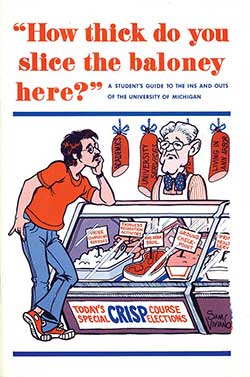
As a U-M student Viviano designed, illustrated, and even edited a freshman guidebook. (Image courtesy of Sam Viviano.) Larger image.
SV: Well, I applied to only two schools. One was Columbia and the other was Michigan. I got accepted at both, and Columbia offered me a scholarship, but even with the scholarship Columbia was so much more expensive than Michigan for me as an in-state student, that I really couldn’t have afforded Columbia.
I also had a certain amount of nervousness about moving to New York at that point in my life. At Michigan there would be plenty of people I knew, and it was only 45 miles away.
AG: Did you enroll in the art school?
SV: No, I was enrolled in LS&A. My first term I had history, great books, calculus, and astronomy, and it didn’t take very long to realize there was no point in me doing all that. I wanted to draw, and why was I taking astronomy?
So my sophomore year I transferred to the art school [since named the Stamps School of Art & Design], and I was actually in the first class to graduate out of the new building on North Campus in 1975. But actually, it didn’t take me very long in art school to realize that I also didn’t want to spend all my time in the studio. I found that kind of oppressive in its own way. I graduated with the minimal amount of art school credits necessary to get a BFA. There wasn’t a BFA major that really interested me, to be honest, because there weren’t any cartooning classes, and there weren’t any illustration classes. So I just got a very general BFA.

Viviano found a creative outlet making posters for live theater on campus. (Courtesy of Vivano.) Larger image.
But I did a lot of stuff on the outside. I did a lot of posters for the theater department and the Gilbert and Sullivan Society and Ann Arbor Civic Theater. I designed, illustrated, and even edited a freshman guidebook for the orientation department. So I really kind of educated myself in the ways of commercial art.
AG: Did you do anything for the Gargoyle?
SV: My only memory of being involved with the Gargoyle was hawking it on the Diag. I think I must have gone to the offices there and said, “Hey, I’m interested,” and they said, “Here, sell the magazine,” and that was all that came of it. I remember my clever line was, “Gargoyle’s back,” and I was holding up the back cover of the magazine. So you can see, I had a very sophisticated sense of humor even then.
I have no regrets about the four years I spent in Ann Arbor. I loved every minute of it. It’s a great place to go to school. On the other hand, I saw a lot of people that hung around after graduation because they liked it so much but really had no reason to be there anymore. They were no longer students, they weren’t really members of the larger Ann Arbor community. They were this kind of vague shadow community of former students.
I didn’t want that. I loved Ann Arbor too much to want to be stuck there, in a sense. So as soon as I was done with school, I packed up the car my mother gave me and I drove around the East Coast for a couple of months and then ended up in New York.
AG: Ready to make your big splash in the Big Apple.

“Subway Man,” 1974. (Image courtesy of Viviano.) Larger Image.
SV: Yeah. Well, I realized very quickly it was going to take a while before I’d become the rich and famous illustrator I hoped to be (and still hope to be someday). I had a portfolio with everything I’d ever done, showing how versatile I was and how broad my skills were.
But at that time in New York, it was not a world of general practitioners. It was a world of specialists. So art directors would look at all this stuff and say, “Well what do you do?” I’d say, “All of it!” “But what do you do?”
So this is the shtick I always give to young artists. I asked myself three questions: “What do you do best?” “What do you enjoy doing most?” “What do you think you can make a living doing?”
For me the answer to all three questions was caricature. So I rebuilt my portfolio, making it nothing but caricature, and I started getting work. The interesting thing that came of that was I got work that didn’t always focus on caricature. I’d get work doing children’s books. It didn’t have anything to do with caricature, but it was a very good apprenticeship.
Now before that happened and I realized I wasn’t going to be a rich and famous illustrator anytime soon, I started looking for other jobs, because I wanted to be self-sufficient. I was looking for secretarial work, because I was a decent typist, but I kept running into brick walls. I’d answer ads for a guy/gal Friday, to give you a sense of the times, and finally one agent said, “Look, you don’t have the legs to be a gal Friday.”
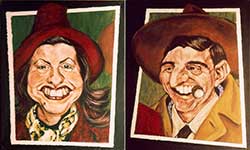
An art school portrait of Viviano’s parents. (Courtesy of Viviano.) Larger image.
Eventually I did get a job. I answered a little classified ad in The New York Times looking for someone who could draw cartoons. It was a textile company that had licenses from “Sesame Street” and Holly Hobbie and Strawberry Shortcake, for children’s fabrics. They had a lot of designers, but they didn’t have anyone who could draw. I didn’t know anything about textiles, but I could draw, so I got hired. I spent a year there and it was actually a great year.
But I knew I didn’t want to be a textile designer the rest of my life, so I quit that job for the uncertain future of a freelance illustrator. I struggled for a while and then my next big break came when I started getting work from Scholastic. In those days they published a lot of magazines that were directly distributed in schools, geared to certain subjects like math or English. Plus, there were a couple of entertainment magazines called Dynamite and Bananas.
AG: I remember those.
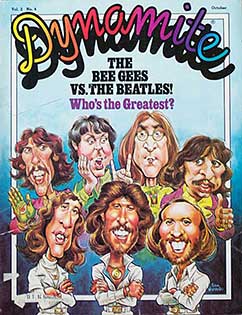
Drawing covers for Dynamite was an early break. (Courtesy of Viviano.) Larger image.
SV: Dynamite was geared to, say, 4th- and 5th-graders, and it was a combination of pop culture and humor. Bananas was for slightly older readers, maybe 7th grade and a little heavier on the humor, a little lighter on the pop culture. They were intelligently put together, had terrific editors and art directors, and I quickly became a regular in both of them.
A lot of the people who worked on those magazines went on to great careers. Bananas was edited by a guy who went by the name of Jovial Bob Stine. He would do movie and television parodies that were not really incisive satire, they were just kind of goofy. He’d write it in a morning and then give it to me and I’d take about a month to draw it. But it was great. It was full color and I had a ball doing it. Eventually Scholastic killed Bananas and they canned Bob Stine, because basically they didn’t have anything for him to do.
Now, he used to write these funny little horror stories in the back of Bananas, kind of like Stephen King for adolescents, and somebody suggested that he do a whole collection of them.
AG: I think I know where you’re going with this.
SV: Yeah. He couldn’t write horror stories as “Jovial Bob” Stine, so he said, “I’ll use my initials.” And he became R.L. Stine, creator of the Goosebumps series, who for many years was the most widely-read author in the United States, and, I would guess, is a millionaire many times over by now. And I knew him when he was a poorly paid editor at Scholastic.
AG: Amazing.
SV: Now, when I was taking my portfolio around — you don’t mind if I just keep running on rather than waiting for a question, do you?
AG: Not at all.
SV: Well, when I first got to New York and I started showing my portfolio around, a bit of advice I kept getting was, “You should go to MAD.” So I dutifully called up MAD magazine and got the art director, John Putnam, on the phone and he said, “Well, listen, I’ve got to be honest with you. It’s a closed shop. We’ve got a dozen artists and they’re the best in the business. We don’t need anybody else. If you want to stop by for a social call, that’s fine.”

Viviano’s first MAD cover in 1981. (Courtesy of Viviano, (c) E.C. Publications.) Larger image.
So I did. I brought my portfolio over to the MAD offices at 485 Madison Ave. and showed them to Putnam and his production guy, Lenny Brenner, and Putnam repeated what he had told me on the phone. But he liked the work enough that he called one of the editors in, Nick Meglin, and Nick looked at my stuff and liked it, too. He said, “You never know — maybe someday there’ll be an opening for you.”
I wasn’t going to hold my breath; the joke among the young illustrators I hung out with was that someone would have to die before you could get into MAD.
Well, in 1980, somebody died — Norman Mingo, MAD’s primary cover artist and the one who had done the first official portrait of Alfred E. Neuman in 1956. Without Mingo, they needed to start looking for cover artists, and an assistant editor, John Ficarra, who had done some writing for Dynamite, I think, suggested me. I was 27 at the time, and I get a call out of the blue from MAD’s editor, Al Feldstein, asking me if I’d like to do a cover. Well, as you can imagine, I was floored, and of course I said I’d do it. And that’s how I got started at MAD.
I was extremely nervous about doing that cover. I did the whole thing and hated it, so I did the whole thing over again. It appeared in the June ’81 issue, no. 223, and it was a portrait of J.R. Ewing from the TV show “Dallas.” You might remember, that was the “Who shot J.R.?” cliffhanger.
AG: I remember.
SV: Well, MAD’s attitude, of course, was “Who cares?” The cover was just a big headshot of J.R. with the 10-gallon hat. There was a six-fingered hand with a pistol pointed at his ear, and out the other ear was a flag with a picture of Alfred E. Neuman and the word “Blecch.”
So that was my first cover for MAD. The issue didn’t sell very well, at least by the standards of 1981, and Feldstein never called me again. I didn’t get my second MAD job until four years later when Nick Meglin and John Ficarra took over as co-editors. That’s sort of really when my MAD career began.
AG: Are there any assignments that you remember over the years at MAD that were particularly notable for some reason — fun, interesting, difficult, unpleasant, or otherwise?
SV: Well, in some sense, every single one had its challenges and its difficulties. I used to imagine what it would be like if I could just picture the work in my head — if I could just snap my fingers and it would appear without having to do all the work.
And then, in 1999, I got my wish. John Ficarra asked if I wanted to be the art director, and that’s really what being the art director is: You picture what it’s going to look like and then you find somebody else to do it.
AG: Okay, so a question we always ask at the end. How did your years at Michigan influence your life? Do you still bleed maize and blue, and all that?
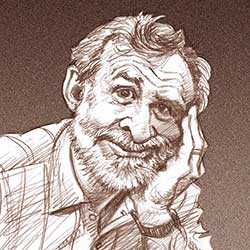
“Self-portrait.” (Image courtesy of Viviano,) Larger image.
SV: Yeah. I mean, I’m not the most fanatic Michigan alumnus. I don’t attend the New York City alumni game-watching nights at whatever bar they do that. But I have nothing but fond memories of my years in Ann Arbor. Although I will tell you this: I’ve given up stopping people in the street who have on Michigan t-shirts or Michigan caps, because invariably I’ll go up and say, “Did you go to Michigan?” and they’ll say, “No, I just like the design.”
But yeah, there are certainly plenty of times I’ll run into someone from Michigan, or from Detroit even, and it’s great because you have that in common.
And I’m proud of a few things. I’m proud that somehow I’m on the Wikipedia page about notable Michigan graduates. I’m proud of that fact that I’ve been invited back to [the Stamps School of Art & Design] on a couple of occasions to speak — once at a special alumni reunion about six or seven years ago, and then again in 2010, as a commencement speaker. I’m very proud of that. It was the same year President Obama gave the commencement address to the University at large in the football stadium. I gave my commencement address later that day in the [Stamps] courtyard and I started out by thanking the president for warming up the crowd for me.
AG: That’s a great story.
(Top image: Sam Viviano, BFA ’75, hard at work in the MAD offices. Courtesy of Viviano.)

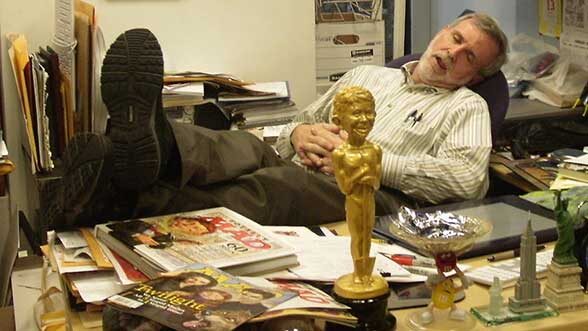


Free Polazzo - 1968
Great article. I loved MAD magazine and especially Sergio Aragones. Was wondering if Sam met him.
I not only collected all his “Groo the Wanderer” Series but when I gave them to my grandsons, they also loved them. Great Art and Great stories. (This is not a paid commercial!)
Free
Reply
Cass Singer - 1981 (Law)
Greetings from a fellow Pilot (Class of ’71) who can corroborate (if not completely commiserate with) your comment about the visual arts (or lack thereof) at the old school. As was said in the day, what a long, strange trip it’s been … Congrats on the recognition here, and best regards.
Reply
Perri Knize - 1976
Sam! It’s wonderful to catch up on your story here. What a sweet surprise to find this article in my inbox. Still remember you fondly from back in the day when you helped me get my bearings in the New York design world of the early 1980s. All these kudos are so well deserved!
Reply
Alan Bernstein - 1991 - Film/Video Studies
Sam’s story is terrific, as is he. You’ll be able to hear more of it straight from the horse’s mouth in “When We Went MAD!” a documentary on the history and influence of MAD Magazine. We are still in production, but you can follow up on our progress by visiting http://www.whenwewentmad.com or https://www.facebook.com/WhenWeWentMAD.
Reply
Paul Schissler - 1975
Great to see this article about Sam. Spent one Summer as a Freshman Orientation Leader with Sam. He did caricatures of all the Leaders that Summer and I still have mine hanging on the wall of my office. I guess that means I’ve thought about Sam, in that round about way, almost every day since then. He was a very dramatic guy, starring in some theater productions and did a mean version of Poe’s “Nevermore” by candle light.
The Freshmen loved that one.
Good for you Sam!!
Reply
Ramona Bashshur - 1984
GREAT story as well as fascinating insight into the world of one of my favorite humor magazines of all time.
Reply
Tom Archambeau - 1975(B.S. Zoology), 1979 (Med)
I met/knew Sam only briefly as a fellow freshman at UM in 1971. Some of my high school classmates from Muskegon were also freshmen at U-M that year, and they somehow knew a few of Sam’s high school friends. As a result we ended up at some of the same freshmen “social gatherings”. Despite the brief time I actually spent with Sam, I still vividly remember how incredibly talented, intelligent, yet quite modest he seemed to be. Even as a freshman, his skill at drawing caricatures would result in friends asking him to draw one for them on the spot, and in no time at all he would produce this amazing caricature of them. I’m happy to learn that his passion became his vocation. All these years later, I still think he must be one of the most talented people I have ever met. Congratulations Sam!
Reply
THOMAS GAINER - SAME AS SAM!
HI SAM VIVIANO…TOM GAINER HERE. DON’T THINK I’VE SEEN YOU SINCE ST MATT’S! I WENT TO BISHOP GALLAGHER…I THINK I REMEMBER YOU WENT TO DE LA SALLE? WITH CHRIS MCBRIDE WHO LIVED 3 DOORS DOWN FROM ME ON 3 MILE DRIVE, AND HAS LIVED IN PHOENIX, AS A LAWYER, FOR YEARS. WELL, GREAT INTERVIEW, NICE GOING ON YOUR CAREER…WOW, NYC AND MAD MAGAZINE…MUST BE (AND HAS BEEN) A THRILL! OF COURSE I LOVED THAT MAG GROWING UP..UNTIL I MATURED INTO PENTHOUSE, OF COURSE. I STILL HANG WITH CASACELI, KAUFMANN, SWANDO, LAETHEM, AND TOM WHITE, NAMES THAT I KNOW YOU KNOW. TAKE CARE, IT’D BE GREAT TO SEE YOU IN NYC WHEN I’M THERE WITH LARRY, WHOSE DAUGHTER LIVES THERE, AND WORKS FOR COLBERT.
Reply
Nora Saady / Trabilsy - St. Matthew Elementary
Sammy (that’s what we called you), I sat next to you in elementary school and remember you drawing! Lovely to see how your life has unfolded.
Reply
Carol (Appleton) Holloway - 1975
Hi, Sam – I also used to call you Sammy, when we were playmates down the street from each other in Detroit. We attended U-M at the same time but our paths never really crossed (I graduated from LS&A). I’m happy for your success, and I hope you feel that you have attained the status of “rich and famous illustrator.” Well, at least famous!
Reply